最近学校要举办ctf比赛,就捣鼓了一下uptime-kuma自动化监测被开放的靶机的运行状态
- GZCTF平台采用 docker + k3s 方式部署
相关资料
Uptime-Kuma-Api
uptime-kuma-api文档
刚开始接触Uptime-Kuma这个网站监控平台,已安装,易上手,界面美观,似乎只能手动添加需要监测的网站。
通过在网上找相关的内容(真的少的)。在这篇博客偶然发现了这个项目Uptime-Kuma-Api,似乎可以实现自动化部署。
(网上关于该api库的使用方法几乎没有,只能看官网文档来摸索了)
效果图:
运行日志
Uptime实时更新 (3min)
最开始使用同步方法写的,运行功能也都正常,但运行十来分钟左右,就会出现如下报错:
遇到了一些报错,应该是 socket.io 库导致的接收到的数据不符合要求
具体原因不清楚,提示包队列为空,可能是因为数据传输中断或没有数据继续处理。
packet queue is empty, aborting
packet queue is empty, aborting
packet queue is empty, aborting
packet queue is empty, aborting
Traceback (most recent call last):
File "uptime_auto_monitor.py", line 164, in <module>
delete_monitor() # 删除 已经关闭的 (DOWN)
File "uptime_auto_monitor.py", line 82, in delete_monitor
monitor_status = api.get_monitor_status(id)
File "/home/st4rry/.pyenv/versions/3.8.6/lib/python3.8/site-packages/uptime_kuma_api/api.py", line 3970, in get_monitor_status
status = heartbeats[heartbeat_monitor_id][-1]["status"]
TypeError: list indices must be integers or slices, not str最后修改代码,增加了异步获取网页数据,经测试连续运行多个小时未出现问题
import asyncio
import logging
import ssl
import aiohttp
from uptime_kuma_api import UptimeKumaApi, MonitorType, AuthMethod, MonitorStatus, UptimeKumaException
# 忽略https证书验证警告
logging.basicConfig(level=logging.DEBUG, format="%(asctime)s - %(levelname)s - %(message)s", filename="log.log")
# TLS证书和密钥读取
tlsCert = open("./cert.crt", "r").read()
tlsKey = open("./key.key", "r").read()
tlsCa = open("./ca.crt", "r").read()
group_id = 11 # 分组ID
# API连接
uptime_kuma_url = 'http://hubuctf.cn:3001/' # 例如:http://127.0.0.1:3001/
username = 'hubuptr'
password = 'HubuPtr123#@!'
api = UptimeKumaApi(uptime_kuma_url)
api.login(username, password)
def create_ssl_context():
"""
创建 SSL 上下文对象,并加载证书
""" context = ssl.create_default_context(ssl.Purpose.CLIENT_AUTH)
context.load_cert_chain(certfile="./cert.crt", keyfile="./key.key", password=None)
context.load_verify_locations(cafile="./ca.crt")
return context
async def check_pod():
"""
查询 pod 并监控其状态
# 该 url 为 k3s 容器的 namespace (gzctf-challenges)下的 pod 的信息
# 获取 k3s的容器的 namespace: (通过接口获取)
# curl -ks --cert cert.crt --key key.key https://ip:6443/api/v1/namespaces/ | jq .items[].metadata.name """ pod_message = {} # {pod_name: creationTimestamp}
url = "https://ip:6443/api/v1/namespaces/<your_namespace>/pods"
# 创建 SSL 上下文
ssl_context = create_ssl_context()
# 使用 aiohttp 发送请求
async with aiohttp.ClientSession() as session:
try:
async with session.get(url, ssl=ssl_context) as response:
req_json = await response.json()
# Ensure that response has the 'items' key
if 'items' in req_json:
for item in req_json['items']:
pod_message[item['metadata']['name']] = item['metadata']['creationTimestamp']
logging.info(f"K3s Active container: {pod_message}")
# 判断 pod 是否在运行
for pod_name, creat_time in pod_message.items():
url = f"https://challenge.hubuctf.cn:6443/api/v1/namespaces/gzctf-challenges/pods/{pod_name}"
async with session.get(url, ssl=ssl_context) as response:
req_json = await response.json()
if req_json['status']['phase'] == 'Running':
logging.info(f"{pod_name} is running, creationTimestamp: {creat_time}")
await auto_add_monitor(pod_name, creat_time)
else:
logging.info(f"{pod_name} is not running")
else:
logging.error(f"Error: Response does not contain 'items'. Response: {req_json}")
except Exception as e:
logging.error(f"Error while checking pods: {e}")
async def auto_add_monitor(pod_name, pod_creation_time):
"""
自动添加监控
""" monitored_name = await get_monitor_name()
new_pod_name = pod_name.rsplit('-', 1)[0]
new_monitor_name = new_pod_name + '-' + pod_creation_time
logging.info(f'**********{new_pod_name + "-" + pod_creation_time} and {monitored_name} ************')
if new_pod_name + '-' + pod_creation_time not in monitored_name:
monotor_url = f"https://challenge.hubuctf.cn:6443/api/v1/namespaces/gzctf-challenges/pods/{pod_name}"
# 采用mTLS认证,需要传入证书和密钥, 忽略证书验证(自签名证书)
# Json 查询模式,查询是否 Running res = api.add_monitor(type=MonitorType.JSON_QUERY, jsonPath='status.phase',
expectedValue="Running", name=f"{new_pod_name}-{pod_creation_time}",
url=monotor_url,
authMethod=AuthMethod.MTLS, tlsCert=tlsCert, tlsKey=tlsKey, tlsCa=tlsCa,
ignoreTls=True,
parent=group_id,
timeout=30)
logging.info(res)
new_id = res['monitorID'] # 新增的监控项的ID, res={'msg': 'Added Successfully.', 'monitorID': 38} await edit_status_page(new_id) # 修改状态页面 (基于save_status_page修改)
else:
logging.info(f"{new_pod_name}-{pod_creation_time} 已经在网站上被监测了")
async def delete_monitor():
"""
删除状态为 DOWN 的监控项
""" monitor_list = api.get_monitors() # No await here, as it's a synchronous function
all_id = [i['id'] for i in monitor_list]
logging.info(f"All monitor id=> {all_id}")
for id in all_id:
logging.info(f"现在查看id为{id}的页面")
try:
if id != group_id:
monitor_status = api.get_monitor_status(id) # No await here either
logging.info(f"页面id为 {id} 的状态{monitor_status}")
if monitor_status == MonitorStatus.DOWN:
api.delete_monitor(id)
logging.info(f"delete monitor {id}")
except UptimeKumaException:
logging.error(f"Monitor with ID {id} does not exist.")
async def edit_status_page(new_id: int):
"""
修改Status页面
uptime-kuma-api 库没有提供局部修改 status page 的方法,因此需要手动获取 status page 的配置,修改 monitorList,再保存
get_status_page(str:str) 的参数为 status page 的 slug,获取方式 api.get_status_pages(),返回值是一个列表,其中的slug即为参数
例如:
[{'id': 1, 'slug': 'hubuctf', 'title': 'HUBUCTF', 'description': None, 'icon': '/icon.svg', 'theme': 'auto', 'published': True, 'showTags': True, 'domainNameList': [], 'customCSS': 'body {\n \n}\n', 'footerText': '', 'showPoweredBy': True, 'googleAnalyticsId': None, 'showCertificateExpiry': True}] :param new_id: 新增的监控项的ID
""" config = api.get_status_page('hubuctf')
publicGroupList = config['publicGroupList']
logging.info(f"old_publicGroupList=> {publicGroupList}")
old_monitorList = publicGroupList[1]['monitorList']
logging.info(f"old_monitorList=> {old_monitorList}")
monitor_new = {'id': new_id}
old_monitorList.append(monitor_new)
logging.info(f"new_publicGroupList=> {publicGroupList}")
res = api.save_status_page(slug="hubuctf", publicGroupList=publicGroupList)
logging.info(f"res=> {res}")
async def get_monitor_name() -> list:
"""
获取所有监控项的名称
""" monitored_name = []
monitor_list = api.get_monitors()
for monitor in monitor_list:
monitored_name.append(monitor['name'])
logging.info(f"已经被监测的项目名字有monitored_name=> {monitored_name}")
return monitored_name
async def status_page():
"""
获取 status 页面信息
""" api.get_status_pages()
a = api.get_status_page('hubuctf')
logging.info(f"Status page: {a}")
async def main():
"""
主函数,定时检查 pod 状态并处理监控项
""" while True:
await check_pod() # 创建
await delete_monitor() # 删除已关闭的(DOWN)
await asyncio.sleep(180)
logging.info("====" * 20 + ">" + "<" + "====" * 20)
if __name__ == "__main__":
asyncio.run(main())代码能够正常运行,且能满足基本功能。



